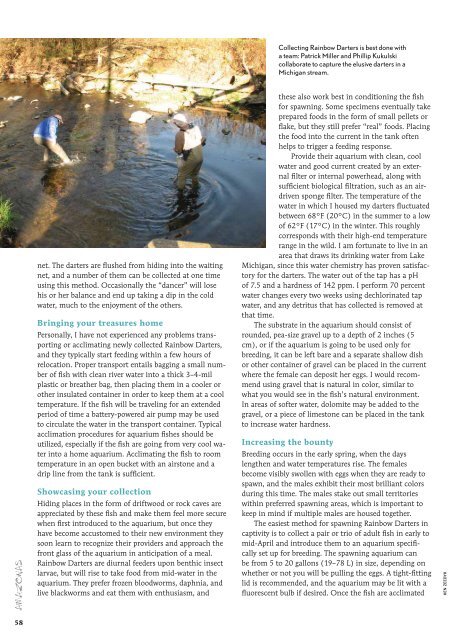Congo Killies - PageSuite
Congo Killies - PageSuite
Congo Killies - PageSuite
Create successful ePaper yourself
Turn your PDF publications into a flip-book with our unique Google optimized e-Paper software.
Collecting Rainbow Darters is best done with<br />
a team: Patrick Miller and Phillip Kukulski<br />
collaborate to capture the elusive darters in a<br />
Michigan stream.<br />
AMAZONAS<br />
net. The darters are flushed from hiding into the waiting<br />
net, and a number of them can be collected at one time<br />
using this method. Occasionally the “dancer” will lose<br />
his or her balance and end up taking a dip in the cold<br />
water, much to the enjoyment of the others.<br />
Bringing your treasures home<br />
Personally, I have not experienced any problems transporting<br />
or acclimating newly collected Rainbow Darters,<br />
and they typically start feeding within a few hours of<br />
relocation. Proper transport entails bagging a small number<br />
of fish with clean river water into a thick 3–4-mil<br />
plastic or breather bag, then placing them in a cooler or<br />
other insulated container in order to keep them at a cool<br />
temperature. If the fish will be traveling for an extended<br />
period of time a battery-powered air pump may be used<br />
to circulate the water in the transport container. Typical<br />
acclimation procedures for aquarium fishes should be<br />
utilized, especially if the fish are going from very cool water<br />
into a home aquarium. Acclimating the fish to room<br />
temperature in an open bucket with an airstone and a<br />
drip line from the tank is sufficient.<br />
Showcasing your collection<br />
Hiding places in the form of driftwood or rock caves are<br />
appreciated by these fish and make them feel more secure<br />
when first introduced to the aquarium, but once they<br />
have become accustomed to their new environment they<br />
soon learn to recognize their providers and approach the<br />
front glass of the aquarium in anticipation of a meal.<br />
Rainbow Darters are diurnal feeders upon benthic insect<br />
larvae, but will rise to take food from mid-water in the<br />
aquarium. They prefer frozen bloodworms, daphnia, and<br />
live blackworms and eat them with enthusiasm, and<br />
these also work best in conditioning the fish<br />
for spawning. Some specimens eventually take<br />
prepared foods in the form of small pellets or<br />
flake, but they still prefer “real” foods. Placing<br />
the food into the current in the tank often<br />
helps to trigger a feeding response.<br />
Provide their aquarium with clean, cool<br />
water and good current created by an external<br />
filter or internal powerhead, along with<br />
sufficient biological filtration, such as an airdriven<br />
sponge filter. The temperature of the<br />
water in which I housed my darters fluctuated<br />
between 68°F (20°C) in the summer to a low<br />
of 62°F (17°C) in the winter. This roughly<br />
corresponds with their high-end temperature<br />
range in the wild. I am fortunate to live in an<br />
area that draws its drinking water from Lake<br />
Michigan, since this water chemistry has proven satisfactory<br />
for the darters. The water out of the tap has a pH<br />
of 7.5 and a hardness of 142 ppm. I perform 70 percent<br />
water changes every two weeks using dechlorinated tap<br />
water, and any detritus that has collected is removed at<br />
that time.<br />
The substrate in the aquarium should consist of<br />
rounded, pea-size gravel up to a depth of 2 inches (5<br />
cm), or if the aquarium is going to be used only for<br />
breeding, it can be left bare and a separate shallow dish<br />
or other container of gravel can be placed in the current<br />
where the female can deposit her eggs. I would recommend<br />
using gravel that is natural in color, similar to<br />
what you would see in the fish’s natural environment.<br />
In areas of softer water, dolomite may be added to the<br />
gravel, or a piece of limestone can be placed in the tank<br />
to increase water hardness.<br />
Increasing the bounty<br />
Breeding occurs in the early spring, when the days<br />
lengthen and water temperatures rise. The females<br />
become visibly swollen with eggs when they are ready to<br />
spawn, and the males exhibit their most brilliant colors<br />
during this time. The males stake out small territories<br />
within preferred spawning areas, which is important to<br />
keep in mind if multiple males are housed together.<br />
The easiest method for spawning Rainbow Darters in<br />
captivity is to collect a pair or trio of adult fish in early to<br />
mid-April and introduce them to an aquarium specifically<br />
set up for breeding. The spawning aquarium can<br />
be from 5 to 20 gallons (19–78 L) in size, depending on<br />
whether or not you will be pulling the eggs. A tight-fitting<br />
lid is recommended, and the aquarium may be lit with a<br />
fluorescent bulb if desired. Once the fish are acclimated<br />
KEN ZEEDYK<br />
58

















